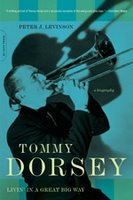
Tommy Dorsey: Livin’ in a Great Big Way
By Peter Levinson
Da Capo Press tradepaper
0-306-81502-8
At the height of his success, Tommy Dorsey acknowledged two bands superior to his: the first was Jimmy Lunceford, and later Count Basie. However, Dorsey’s influence on American popular music is enormous, as Peter Levinson chronicles in his biography, Tommy Dorsey: Livin’ in a Great Big Way.
Tommy Dorsey’s story is of course intertwined with that of his alto playing brother, Jimmy Dorsey. Levinson describes an often strained relationship between the band-leading brothers, in which: “Almost from the beginning, the two brothers referred to each other as ‘The Brother’ or ‘Brother.’” (p. 6) In his assessment of the Dorseys, Levinson suggests Jimmy was the superior musician, but Tommy Dorsey was the one with the leadership ability.
Dorsey employed some of the best musicians of the 1930’s and 1940’s including: Buddy Morrow, Ziggy Elman, Charlie Shavers, Louis Bellson, Buddy Rich, Dick Haymes, and a young Frank Sinatra. His eye for talent also extended to the business side of the industry. Rejected by the military for health reasons, Charlie Wick became a part of the Dorsey organization as an arranger and manager of Dorsey’s ballroom. It would be the start of an interesting career for Wick, as Levinson details:
“Wick later made a successful transition into other areas, which included making the publishing deal for Winston Churchill’s epic series History of the English-Speaking Peoples and advising Ronald Reagan in his gubernatorial bid in California. Later, he served in the Reagan administration for two terms as director of the U.S. Information Agency (USIA).” (p. 169)
Dorsey’s outfit consistently ranked at the top of each big band category, but events of the 1940’s would have a tremendous impact on the band business. The American Federation of Musicians’ luddite recording strike, designed to combat the growing influence of radio and juke boxes had a disastrous effect on swing musicians. As Levinson writes:
“The ill-conceived recording ban was finally lifted in November 1944. It was finally obvious to [union boss] James C. Petrillo that the ban on recordings using musicians didn’t result in more work for them in other areas. On the contrary, it provided less employment.” (p. 185)
Ironically, Dorsey would have a hand in driving the final nail into the coffin of the swing era. Stage Show, the variety television show hosted by the Dorsey Brothers in the 1950’s is remembered for two things. Reports that Charlie Parker was watching it the night he died provide one claim to trivia immortality. Stage Show was also the venue for Elvis Presley’s television debut, well before his celebrated performance on Ed Sullivan. According to Levinson, many in the band did not see the Presley appeal, but Dorsey’s eye for talent was as sharp as ever:
“[Band member] John Frosk added, ‘We didn’t like him because he looked dirty, and he needed a haircut. We thought he never bathed.’ But at the end of the rehearsal, Louis Bellson recalled, Tommy said, “You see that guy Elvis Presley—he’s going to be one of the biggest names in show business in a short time.’” (p. 288)
His appearances of Stage Show clearly led to bigger things for Presley. One can argue for a place in rock & roll history for Tommy Dorsey simply for helping make Presley a star. Considering the number of instruments the Dorsey Brothers destroyed in their sibling fights, one might claim they were forerunners of The Who as well.
There many revealing anecdotes collected in Livin,’ and Levinson is not shy about covering the more scandalous events of Dorsey’s life. Levinson seems to have mixed feelings about Tommy Dorsey, the man, but is a staunch defender of Dorsey’s music. The resulting biography is fast reading and totally entertaining, regardless of how one feels about the man or his music.